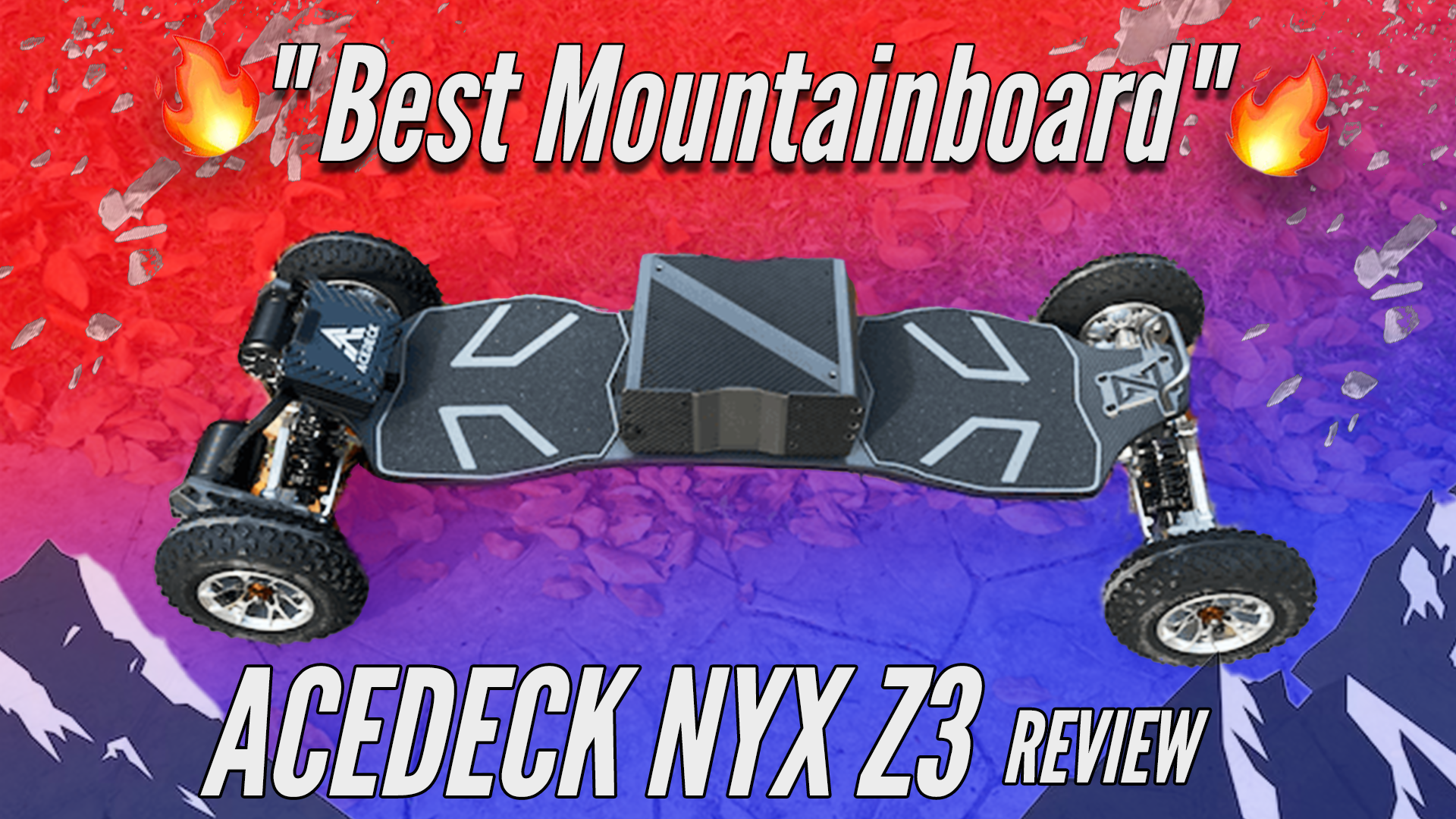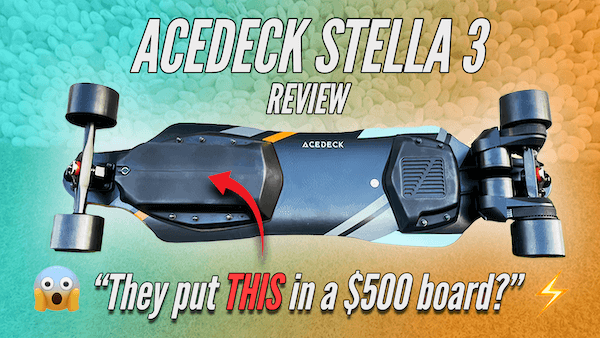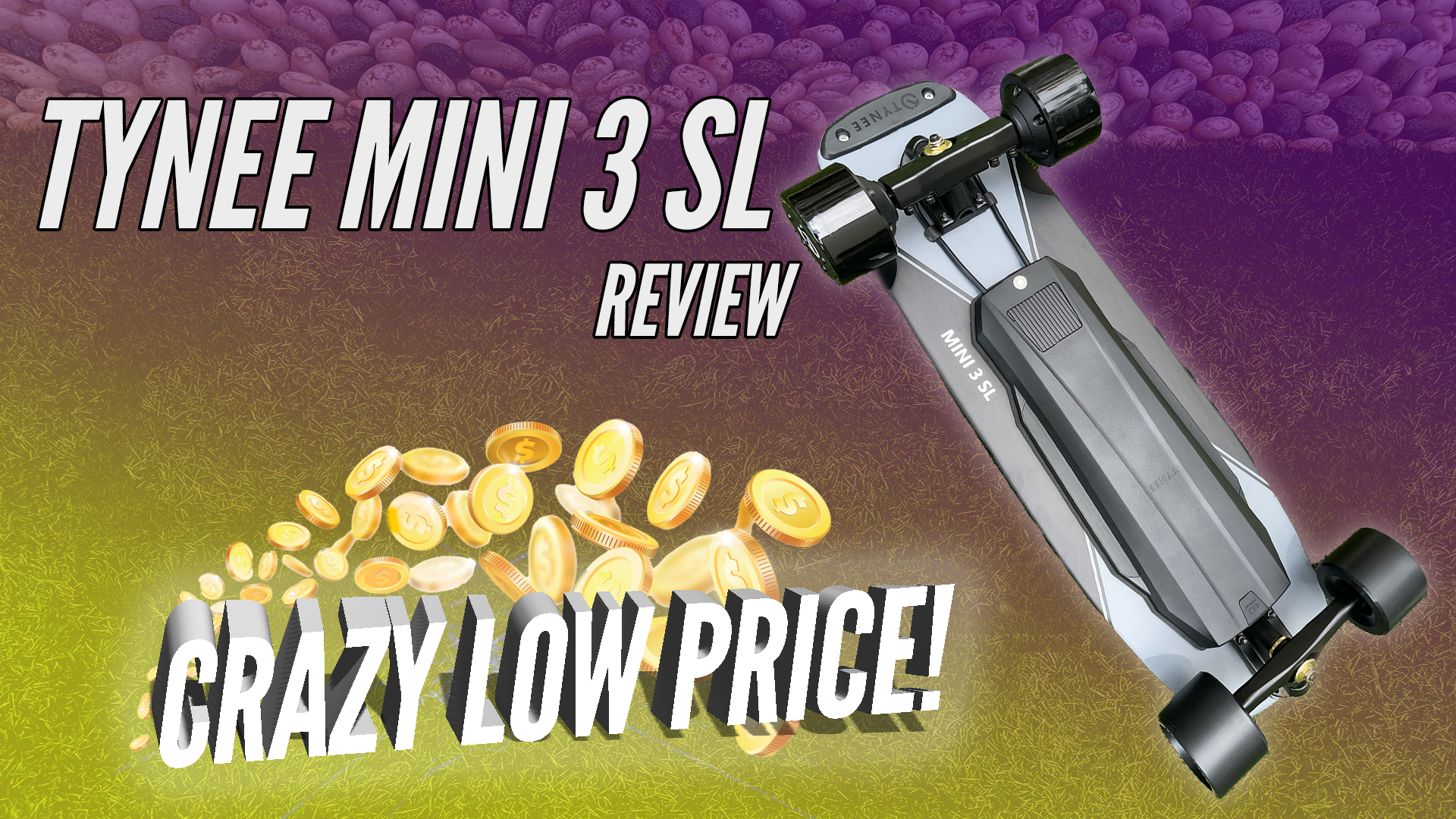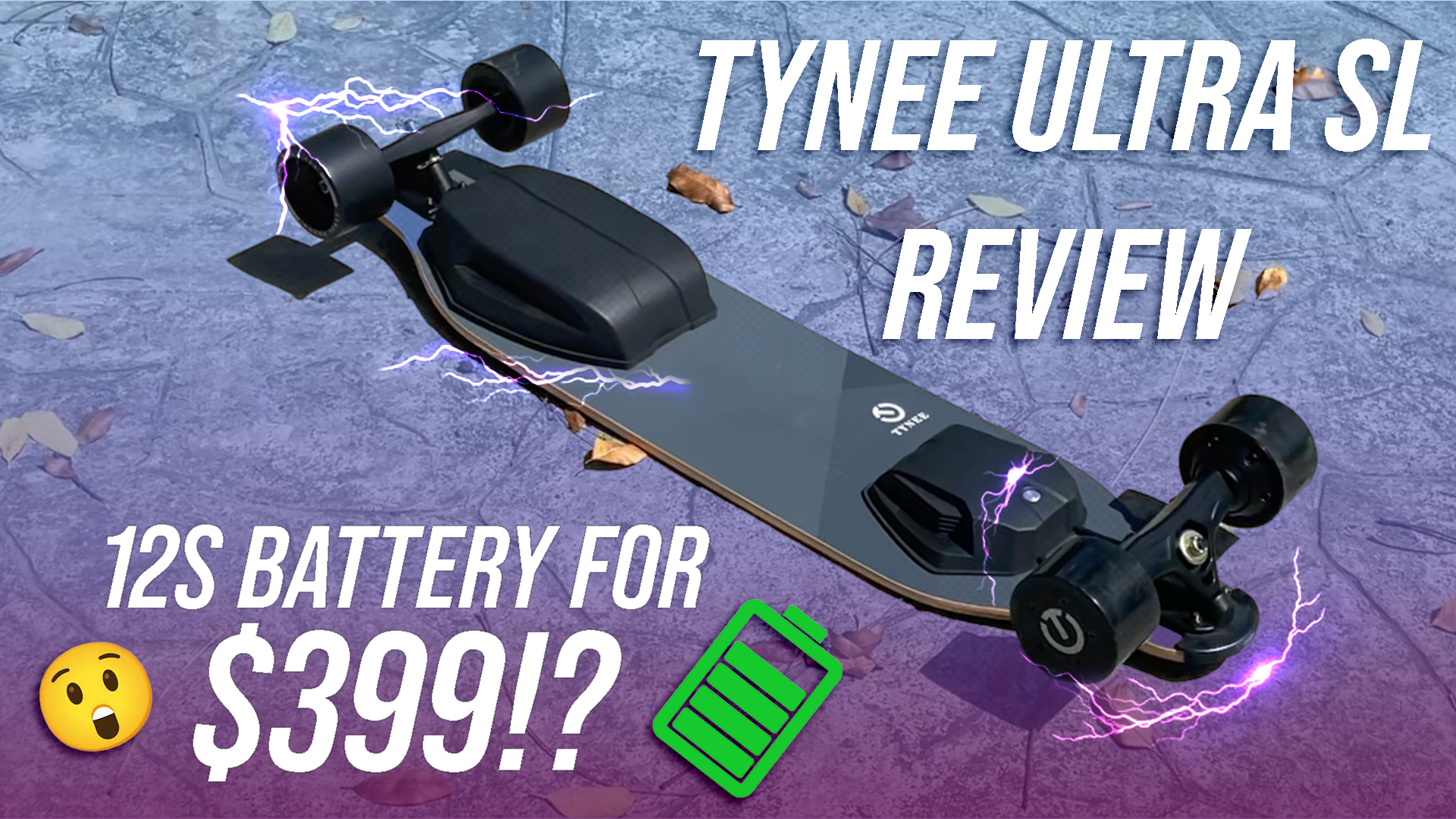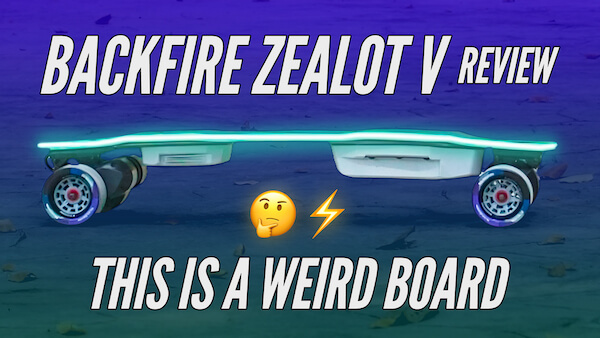In 2023, we saw Kaly.nyc and Lacroix closing shops. Rising from the dust is Acedeck with its Nyx Z1, and this year, they’ve launched the latest edition of the series, the Nyx Z3.
We don’t know why they skipped over Z2, but we do know that the Nyx Z1 was wildly popular as one of the better mountain board builds. The 2024 Nyx Z3 has some upgrades, including a new shock-absorbing truck system, integrated lights, and an option for a bigger 14s6p battery.


Acedeck Nyx Z3 Specs:
| Nyx Z3 Off Road (653Wh) | Nyx Z3 Off Road (1036Wh) | Nyx Z3 Off Road (1295Wh) | Nyx Z3 Off Road Elite (1554Wh) | |
| Price | $1599 | $1999 | $2399 | $2899 |
| Battery | 14s3p 653Wh Molicel P42A | 14s4p 1036Wh Samsung | 14s5p 1295Wh Samsung | 14s6p 1554Wh Samsung |
| Controller | Custom Acedeck ESC | |||
| Top Speed | 37 Mph (60 Kph) | |||
| Range | 24 miles (40 km) | 37 miles (60 km) | 49 miles (80 km) | 59 miles (95 km) |
| Deck | Multi-layer composite deck | |||
| Motor | 6384 150KV 4500W*2 Gear drive | |||
| Net Weight | 18.9kg (41.67lbs) | 20.2kg (44.53lbs) | 21.2kg (46.74lbs) | 22.1kg (48.72lbs) |
Deck – Multi-Layer Composite Deck



Starting with the deck, the Nyx Z3 is a mountainboard deck made of a multi-layer composite maple, bamboo, and carbon fiber. The Z3’s flexible deck, which carries over from the Nyx Z1, effectively dampens vibrations. This design is a favorite among off-roaders and die-hard eskaters because it places the battery box atop the deck, allowing for maximum ground clearance.
The deck boasts a moderate concave and sufficient flexibility, as expected from a build like this.
Pre-drilled holes for foot bindings are included, although Acedeck does not currently provide foot bindings out of the box. Additionally, the front handle adds convenience to the board’s design.
ESC and Remote – Custom Acedeck ESC:


Moving onto the ESC, Acedeck used their custom ESC, presumably modeled after the trusty Hobbywing ESC. It comes with four-speed settings and a smart turn-on feature. The board is paired with the standard Hobbywing remote with a screen for telemetry where the board’s power, top, speed, acceleration curve, and braking can be customized through the remote menu.
Battery – 14s Samsung Molicel:


As the Nyx Z3 is an all-terrain adrenaline beast, it comes as no surprise it’s powered by some beefy battery units. All Nyx Z3 versions have a 14s battery arrangement, ranging from 653Wh to a whopping 1554Wh.
With a 14s4p battery configuration, our model, the 1036Wh, is marketed as having a range of up to 37 miles (60km). And in our tests, with both a 154lbs (70 kg) rider and a 220lbs (100kg) rider taking turns, we managed to make it to 26 miles (42 km) while riding fast.
Motor – 6384 150kv Dual 4500W Gear Drive:



Now, let’s talk about the gear drive. This is a 6384 150KV 4500W*2 gear drive system. We always expected gear drives from a higher-ended board, and Acedeck is no stranger to putting gear drives into their boards, as all of their premium line-ups use gear drives. It’s also a fully enclosed system so you never have to be afraid of debris getting stuck in the motor system and ruining your ride. Here, the gear ratio is 4:1.
We tested these motors and were able to reach 34.18 mph (55 kph), out of their advertised top speed of 37.28 mph (60 km/h).
Trucks and Wheels – Suspension Trucks and 8-inch AT Wheels:



As for the trucks, the Nyx Z3 features a new and different suspension system, which is different from what we have seen from Propel, Ecombl, and Bajaboard. Unlike conventional trucks, the Nyx Z3 utilizes a compact design based on a channel truck platform, and Acedeck claims that it would be more stable and comfortable than what other brands put out. Systems like this allow the four tires to move up and down independently from each other, improving the board’s smoothness on uneven surfaces.
There are two ways to change the truck’s tightness.
Replace both bushings with the red 85A bushing for heavier riders, or swap out all of the bushings with the white 75A bushing for more flexible steering. The screw’s tightness will also have an impact on how tight the truck is; just like with a regular truck, tightening the screw here will pressure the bushings and increase the truck’s stability. It’s helpful to have Loctite with you if you were to tinker with the screws, as if it gets too loose, the truck will be wobbly.
Paired with the trucks are these wheels 8-inch all-terrain wheels, pretty standard here.
The board itself is obviously heavy as well; the lightest version weighs 41 lbs (19 kg), and the heaviest is the Elite version, which weighs 49 lbs (22 kg).
You also have the option to buy a variant with the 1100-lumen premium front lights, but that will set you back another $120 bucks. Ours didn’t come with the lights, but every variant of the Nyx Z3 does come with integrated brake lights, which turn on when you apply the brakes
Specs Summary of the Acedeck Nyx Z3:



If you are buying a $1999, I would assume you are not the type of person who puts too much focus on how much specs you get per dollar you spend. You are probably more concerned with the product quality and the entire ride experience in this case.
However, we at Electric Skateboard HQ love our charts and numbers and couldn’t resist making that comparison. We expected Nyx Z3 to cost more or have fewer specs than boards at a similar price, since mountain board style decks, gear drives, and suspension trucks are more expensive to design and manufacture than other boards yet what we found is that the Nyx Z3 was actually priced lower than comparable boards on the market.
It’s not too hard to see why Acedeck has been such a rising star when they can put out high-end boards that were built beautifully while managing to price them lower than competitors.
Ride Experience of Acedeck Nyx Z3


With builds like this, we expect torque and power for off-road rides and pray that the board has good speed control to harness that power comfortably.
We expect the suspension trucks and flexible deck to absorb most of the road vibration and be super stable on ‘straight-line’ but hope it’s not too difficult to turn and make it unrideable on sidewalks with tight turns.
And this is what we feel about the board after riding it: Nyx Z3 is definitely a superb mountain board that can handle mountain trails and any road conditions. It has a strong torque, and you will feel the high-voltage system in action. The acceleration is quick and punchy and can easily propel you to the top speed. Acedeck did a beautiful job configuring the speed control, and even though the acceleration is rapid and strong, it wasn’t harsh and didn’t have the jolt that many boards with LingYi ESC might have.
The braking is equally smooth but strong; those who like strong brakes would be happy about this. However, the brake is not able to lock the board when halting on an incline; it is almost able to, but the board will still slide down very, very slowly.
The suspension system also did amazingly well. No road vibration whatsoever when riding off-road. It is hard for us to draw a comparison between this suspension truck and other suspension trucks, such as the one on Propels, as both did their job completely well.


But strictly speaking, the Nyx Z3 has an advantage here since, unlike the Propel Endeavours, it also features a flexible deck where you can put foot bindings for bouncy off-road conditions.
Many riders vouch for foot bindings, not so much for their off-road security as for their ability to shift your body weight aggressively for tighter turns, which brings us to the next point: maneuverability.
Right out of the box, this is really a ‘straight-line’ box for us. It is heavy to turn, but very easy and stable to travel in a straight line. Keep in mind, we are scrawny Asian here, and it’s not easy for our 155 lbs weight to turn the trucks. However, there are solutions: the trucks were considerably easier to turn and much more responsive after we switched to the white 75A bushing.
At the end of the day, you can choose a configuration that suits you perfectly. Of course, Acedeck did not miraculously find a way to make suspension trucks that are also easy to turn, but we think this is as good as it gets. With the right configuration, this is easier to turn and more responsive than the suspension trucks on the Propel Endeavors2 Pro.
In terms of responsiveness, these trucks are somewhere between TKP trucks and Double Kingpin. That’s if you take the time to configure them right.
Verdict – Acedeck Nyx Z3:



Until competition catches up, Acedeck Nyx Z3 is undoubtedly the best option for a mountain board like this. It is a board that will get you a lot of attention during a group ride and then also leaves everyone in the dust during the said group ride. It is a board that is super comfortable and powerful enough to ride alongside road traffic with no fear of potholes, but it may be less practical if you have to maneuver around other people on the sidewalks.
It’s also a board that you can use for off-road trail runs when you’re in the mood for some extra excitement. Essentially, if you have the money, you should get the Nyx Z3, which has all the excitement that an electric skateboard can provide.
If you are interested in buying the Acedeck, be sure to check out our affiliate discount link here and use code: “ESKATEHQ” to receive $5 off during checkout.
It will help you get a small monetary discount and help us out too. On top of that, you’ll be tagged as an Electric Skateboard HQ customer and probably be treated better. Cheers!




